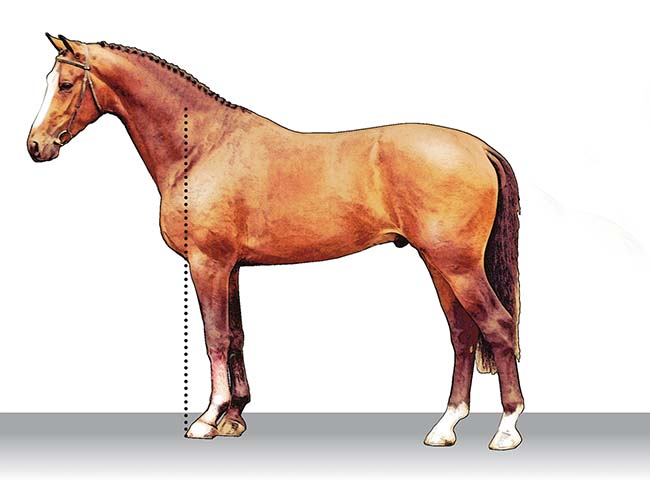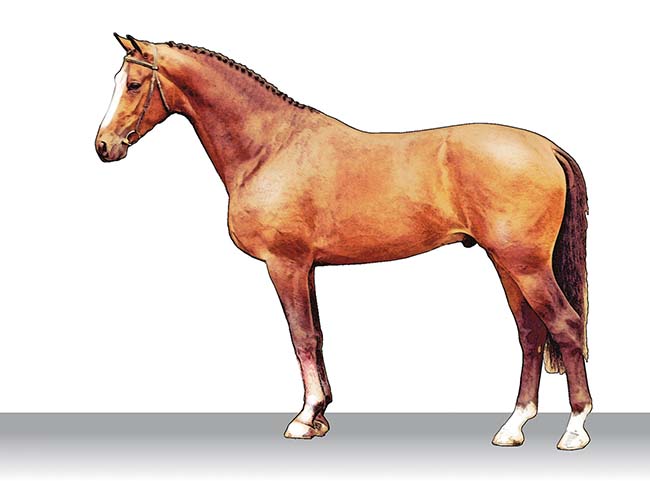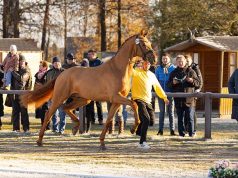By KWPN
Photography: Courtesy KWPN
The KWPN pays close attention to correct conformation, which allows the horse to perform its work easily and, as a result, enjoy a long sport career. Correct leg conformation is an important part of this concept. Together with inspectors Floor Dröge and Henk Dirksen, we shine a light on this subject.
When a horse is presented at a KWPN inspection, the jury first evaluates its stance and conformation. By viewing it from both the side and the front, they can observe the various leg angles. The evaluation of the front legs begins with an assessment of the horse’s stance relative to its body. Senior dressage inspector Floor Dröge explains: “The front leg should stand straight under the body. This way, the horse can easily bring the leg forward and develop scope in the stride. However, the leg in some horses is positioned slightly under the body, which we call ‘camped under’. This need not be a problem, but you can see it in the movement sequence: the horse can’t bring its leg forward as easily and doesn’t have as much shoulder freedom.
Senior jumper inspector Henk Dirksen also sees this issue in show jumpers: “You often see that these horses jump slightly over the front leg, which comes at the expense of the front leg technique.” However, this issue does not have veterinary significance.
Next, the jury draws an imaginary straight line through the front leg. Dröge: “We then look if the leg is over- or back at the knee. We don’t consider a bit of either bad, but never too much! We regularly see horses that are fairly back at the knee, in which the knee is positioned behind the plumb line and relatively overstretched. We hear from practice that this regularly leads to accelerated wear and tear.”
Dirksen: “In showjumpers, we sometimes see horses with an over-at-the-knee front leg. It certainly doesn’t put them at a disadvantage: they use their knees better and, as a result, seem to have less wear and tear.” Over-at-the-knee conformation is rare in dressage horses.


Paying attention to the hooves
The jury also views the hoof angle and the height of the heels from the side. Dissimiliar feet lead to an asymmetrical gait. And with reduced load on the back half of the hoof, the hoof mechanism is less functional. If the differences are very great and, as a result, the asymmetry is very significant, it can be a problem. Dröge: “Obviously, dissimilar front feet are a disadvantage for a horse. These horses always move out of balance, like having a sneaker on one foot and a heel on the other and then having to run a marathon like that. This regularly causes problems that eventually manifest as wear and tear, and lameness.”
Next, the jury views the horse moving away and towards them on a straight line. This procedure allows them to properly evaluate the stance of the front feet, viewed from the front. If the horse’s feet are turned outward, we call this ‘toed out’; conversely, if the feet are turned inward, we call this ‘toed in’.
Dirksen: “We always strive for a correct stance, but we sometimes overlook a toed-out stance, provided that it’s not too severe. We take more issue when the front feet are toed in.”
Dröge: “We always evaluate a horse for this in the walk. If the horse is standing, it can look very different. It’s especially important that the foot is placed down flat. If the horse loads the outside or inside more, then that’s a problem.” .. To read the complete article you need to be a subscriber
CLICK HERE TO SUBSCRIBE TO BREEDING NEWS
SUBSCRIBERS CAN READ THE COMPLETE ARTICLE BY LOGGING IN AND RETURNING TO THIS PAGE



